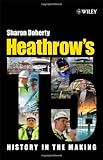| Title: | Heathrow's Terminal 5: History in the Making |
| Categories: | Construction |
| Authors: | Sharon Doherty |
| ISBN-10(13): | 0470754354 |
| Publisher: | Wiley-Blackwell |
| Publication date: | 2008-04-07 |
| Edition: | illustrated edition |
| Number of pages: | 372 |
| Language: | English |
| Picture: |

|
| Review: |
It has been well documented in the past that many mega projects in the UK such as Wembley Stadium, the British Library and the Scottish Parliament to name a few have failed in terms of time and cost objectives. This failure has resulted in serious time and cost overruns arguably as a result of poor overall planning and management of these projects. This particular book is based upon what could be argued as the most successful mega project ever to be completed in the UK in terms of meeting time and cost and as such highlights a reversal of the apparently established trend of under-performance. Mega projects needn't experience time and cost overruns. The book provides a fascinating insight into the building of Heathrow Airport's Terminal 5 (T5) . Written by an HR and organisational effectiveness director involved in the building of T5, the book comprises twelve sections and is a most welcome and interesting text for construction based practitioners and academics interested in project management and leadership and the related aspects of management theory. The book takes the reader step-by-step through the building of T5 covering: the initial planning inquiry; the design and construction phases; and the critical success factors. The critical success factors deal with leadership, motivating people, the role of the client and integrating the construction teams. The book also provides a 'final verdict of the whole project'. Many management based books I have read over my academic career have been particularly dry and you only tend to be engrossed in one or two sections or read certain chapters of a book. With this book it was different. I greatly enjoyed reading every chapter finding each to be most interesting and informative as indeed any reader will. Each chapter provides some real in-depth information into the building and management of this mega project. Having viewed T5 at first hand on my way to New Zealand a short while ago I must say that this is a signature building of great stature and one which will prove over time to be the gateway to the UK. The first few chapters provide an introduction, an insight into aviation trends and performance and reviews the very lengthy planning inquiry. When you read final verdict which states 'twenty two years in the making' you do realise that the UK has a serious problems to deal with in terms of simplifying the whole planning process. These major projects are not only huge in terms of economic benefit but also human benefit. The planning process seems unable to cope with the enormity of the implications of such projects. Some of you reading this review may disagree that projects like T5 are of human benefit and indeed those living in close proximity to Heathrow will also argue against this claim. However, in a project such as this the economic benefits of the project will always, in my opinion, be the deciding factor. T5 is a powerful economic asset that generates economic activity, is a gateway to the UK and provides many people based in the south east of the country with employment, it is difficult to object to these benefits. In the middle section of the book the author provides the reader with an insight into the design and construction phases of the project. The author focuses, in particular, on the role of the client at the design stage. Also described in detail is the role of the key players in the construction phase of the project which, in this project, was key to its overall success. The last few sections move onto the critical success factors focusing on leadership, motivation and most significantly the strategic frameworks used to create the successful T5 project environment. The summary section to the book was the most disappointing aspect of the whole reading experience being too brief. The book would benefit from at least three further chapters on building construction , the opening and the immediate operational experience. A section on how the actual buildings within the project were built and constructed from technology viewpoint is greatly needed. For completeness dealing with the commissioning and opening of the project is, I believe, also needed. Finally a chapter dealing with the problems experienced shortly after the opening of the project would complete the review. I appreciate that no book can be exhaustive but the inclusion of these chapters would add to the book and potentially add to the overall readership of the book. Overall this a fine addition to any bookshelf but more importantly it should to be read it is extremely easy to read and very well written. Dr Nigel Craig Glasgow Caledonian University. |



